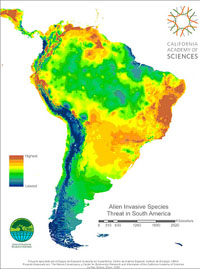 |
Invasive Alien Species
Invasive alien species (IAS) are the second most important cause of biodiversity loss next to habitat alteration and climate change. In Latin America, economic losses from IAS amount to billions of dollars annually, but strategies to minimize the damage of IAS are generally underdeveloped. Together with researchers from The Nature Conservancy (TNC), and the Centro de Analisis Espacial of the Universidad Mayor de San Andres in Bolivia, CBRI is using ensemble distribution modeling to generate composite maps that predict the distribution of 150 of the most threatening IAS in South America.
To build these maps, species occurrence data, derived from both museum specimens and observations; obtained from the TNC Invasive Species Initiative, the IABIN Invasive Species Information Network (I3N), and the Global Biodiversity Information Facility (GBIF) are used. Researchers combine these data with global environmental data layers in models to identify IAS ‘hotspots’ and plan to stop invasions before they begin.
|

